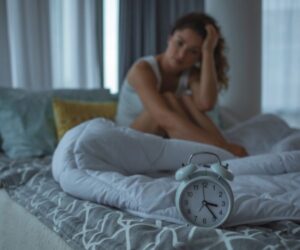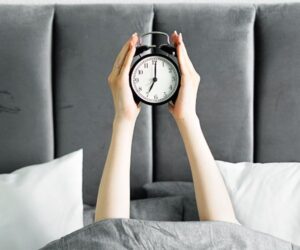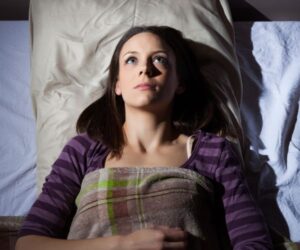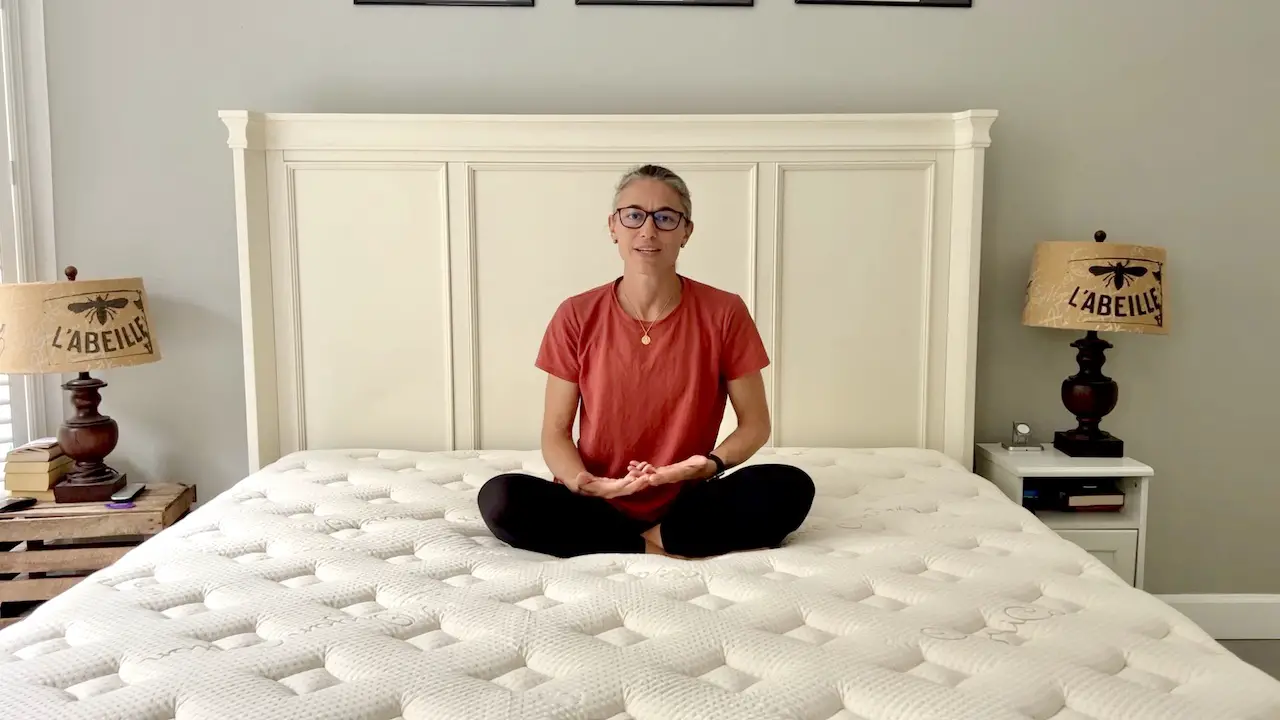SYMPTOMS OF DELAYED SLEEP PHASE DISORDER (DSPD)
With Tips & Intervention Strategies
When your sleep schedule feels like it’s perpetually shifted later—no matter how hard you try to force an earlier bedtime—you might be wrestling with a circadian rhythm issue known as Delayed Sleep Phase Disorder (DSPD) (also called delayed sleep–wake phase disorder). For those seeking better rest by aligning your internal clock, understanding the symptoms of delayed sleep phase disorder is a vital first step.
Let’s take a deeper look at what DSPD is, what symptoms to look out for, how it affects daily life, how it differs from simply being a “night owl,” when to see a professional, and some tips & interventions that may help.
Note: this article does not constitute medical advice. Consult a health specialist to discuss a personal plan.
Table of Contents
What Is Delayed Sleep Phase Disorder (DSPD)?
Before detailing the symptoms, it helps to understand what DSPD exactly is—and how it differs from other sleep issues.
Definition & circadian misalignment. DSPD is a circadian rhythm sleep disorder in which a person’s natural sleep–wake cycle is persistently delayed relative to typical or socially acceptable times. In other words, their internal clock “wants” to initiate sleep later in the night (often after midnight) and correspondingly wants to wake up later in the day.
Chronic pattern. It is not just an occasional jet-lagged shift; the delay is persistent (typically lasting three months or more) and causes functional impairment.
Alignment when unconstrained. One key feature distinguishing DSPD from simple insomnia is: if you are free to follow your natural rhythm (e.g. during vacations or weekends), you may sleep well—just very late.
Not just preference. Unlike a casual “night owl” who might choose to stay up late, someone with DSPD has difficulty falling asleep earlier even when sleepy, due to misalignment between internal signals (like melatonin timing) and external time cues.
Because your sleep timing is shifted, many of the consequences of DSPD are downstream symptoms—especially when daily commitments force a mismatch between your biological clock and your schedule.
Core Symptoms of Delayed Sleep Phase Disorder
Below is a detailed breakdown of the key symptoms of delayed sleep phase disorder—the red flags that suggest the delay is more than a habit.
1. Persistent Difficulty Falling Asleep at Conventional Bedtime
Delayed sleep onset: The most characteristic symptom is that you are unable to fall asleep at what most consider a normal—or desired—bedtime. For instance, lying awake from 10 pm to midnight or later, despite efforts to sleep.
Insomnia when attempting early bedtimes: If you force yourself into bed earlier than your internal rhythm, you may toss and turn, experience anxiety about sleep, or simply remain unable to drift off.
Stable but late sleep onset: Often, the time you can fall asleep is fairly consistent (e.g. always around 2–4 a.m.), even though it’s shifted from the norm.
No major difficulty remaining asleep once you fall asleep: In many cases, the problem is not waking frequently—but the problem is when you fall asleep.
2. Difficulty Waking Up at a Conventional or Required Time
Trouble rising in the morning: Because your internal clock hasn’t yet cued your body to wake, conventional wake-up times may feel impossible. You may “oversleep” or require multiple alarms.
Snoozing, “dead time,” or prolonged grogginess: Even when you awaken, you might feel a heavy inertia, sluggish, or disoriented (often called sleep inertia).
Frequent lateness, absenteeism, or conflict with obligations: Because the body resists early wake times, you may be chronically late to school, work, or social events—or try to “catch up” by oversleeping.
Extended sleep on free days: On weekends or vacations, you may naturally drift to very late bedtimes and wake times, often sleeping in into the late morning or afternoon. This is often your “true” rhythm showing itself.
3. Excessive Daytime Sleepiness or Fatigue
Persistent daytime drowsiness: When your schedule forces you to wake earlier than your body wants, you may feel chronically sleepy, struggle to stay awake, or nod off in unsuitable moments (e.g. meetings, lectures).
Difficulty concentrating, focusing, or mental “fog”: Sleep deprivation from shifted timing can impair attention, memory, and cognitive processing.
Reduced productivity or performance: Work output, decision-making, and learning may suffer because of chronic misalignment and sleeplessness.
Compensatory napping or “catch-up” sleep: To cope, people often nap or sleep extra when possible, which can further confuse the circadian system.
4. Mood Disturbances, Behavioral or Psychological Effects
Irritability, mood swings, or low tolerance: Fatigue can exacerbate emotional reactivity.
Depression or anxiety: DSPD is associated with an increased risk of comorbid mood disorders, sometimes because of the social strain of being out of sync.
Social withdrawal or isolation: Because many daytime hours are spent in fatigue or catching up, evening socialization may seem easier—leading to a cycle of late-night social habits.
Poor school/work attendance, tardiness, or underachievement: Particularly in adolescents, the misalignment may lead to chronic lateness, skipping classes, or trouble meeting deadlines.
Co-occurring conditions: There is a known overlap between DSPD and ADHD, mood disorders, and sometimes substance use (e.g. reliance on stimulants or sedatives).
5. Other Characteristic Features & Clues
Stable delayed pattern: The late bedtime and wake time tend to be fairly consistent over weeks to months.
Lack of flexibility in shifting earlier: Attempts to “go to bed earlier” often fail repeatedly.
Sensitivity to evening light or screens: Exposure to blue light in the evenings (e.g. from screens) may further delay melatonin onset, worsening the disorder.
Relative normal sleep when allowed: If given freedom to follow one’s internal clock, the person may sleep well (though late).
Minimal insomnia outside of the shifted timing: The major complaint is when you fall asleep and wake up—not necessarily how well you sleep once asleep.
Possible genetic/familial link: Some people with DSPD have family members who also have late-sleeping tendencies, suggesting a heritable circadian trait.
How Symptoms Vary by Severity and Demographic Factors
DSPD isn’t one-size-fits-all. The severity (how late sleep is delayed, how disruptive the symptoms are) and individual factors (age, lifestyle, social demands) shape how symptoms show.
Mild vs severe delay: In milder cases, the delay might be only 1–2 hours; more severe DSPD may involve delays of 3–6 hours or more.
Age and life stage:
• Adolescents and young adults: DSPD often begins or worsens during puberty or late adolescence. Many teens already shift later as part of normal development.
• Adults: In adults, DSPD can persist or emerge. Social or work obligations often exacerbate the challenge.Impact of external demands: The more rigid your schedule (e.g. school start times, 9–5 jobs), the more noticeable the symptoms. Conversely, flexible or night-shift work might mask the effects.
Comorbidities amplify symptoms: Mood disorders, ADHD, or other sleep disorders may intensify or complicate symptoms.
Lifestyle amplifiers: Late-night screen use, irregular sleep-wake times, shift work, caffeine use, or insufficient morning light can worsen severity.
Because severity and personal factors influence how severe symptoms feel, two individuals with DSPD may report quite different daily experiences—one might feel only mildly delayed, the other severely impaired in work and social life.
How “Symptoms of Delayed Sleep Phase Disorder” Differ from Other Sleep Issues
Recognizing DSPD—and not mislabeling it as insomnia or poor sleep hygiene—is key. Here are distinguishing features:
| Feature | DSPD | Insomnia / poor sleep hygiene | Night-owl / lifestyle choice |
|---|---|---|---|
| Main issue | Timing of sleep is delayed | Difficulty initiating or maintaining sleep at conventional times | Preference to stay up late, but generally flexible |
| Consistency | Persistent late onset & wake times, fairly stable | May vary night to night | May shift later but often can “reset” for obligations |
| Ability to sleep when allowed | Often sleep well if allowed to wake late | Sleep quality is poor even if schedule is free | Sleep quality may vary, but not chronically misaligned |
| Response to sleep hygiene / behavioral attempts | Resistant to early-bedtime attempts | Often responds to improved sleep habits | May improve by changing habits |
| Functional impairment | Because of mismatch with daily schedule | Because of sleep loss generally | May exist but often resolvable with choice |
If someone tries improving their mattress, blackout curtains, or “sleep hygiene” but still cannot fall asleep until very late and cannot reliably wake early, those are strong hints toward DSPD rather than straightforward insomnia.
When to Seek Professional Assessment
If the symptoms of delayed sleep phase disorder are persistent (e.g. three months or more) and are visibly interfering with your daily life—work, study, relationships, mood—it may be time to consult a sleep specialist or physician.
Points to consider:
Duration & chronic impact: Symptoms lasting months, not just weeks, especially with daytime impairment.
Failed self-help efforts: If improving sleep hygiene, sticking to consistent schedules, reducing screen time, or controlling light exposure have not alleviated the problem.
Suspected comorbid disorders: Mood issues, ADHD, insomnia, or other sleep disorders may need assessment.
Objective measurement: Professionals may use sleep diaries, actigraphy (wrist monitors), and in some cases polysomnography to rule out other disorders.
Impact on health or safety: Severe fatigue, daytime microsleeps, or impairment in performance (driving, work) warrants medical intervention.
A correct diagnosis allows for targeted treatments (see next section) rather than generic sleep tips that may not address circadian misalignment.
Tips & Interventions That Target DSPD Symptoms
Here are evidence-based strategies that may help mitigate or manage the symptoms of delayed sleep phase disorder. These are often used in combination, and success depends on consistency and individual adherence.
1. Gradual Sleep Schedule Adjustment
Phase advance protocol: Gradually move bedtime earlier (e.g. 15–30 minutes every few days) until you reach a desired earlier time.
Chronotherapy (controlled delay then advance): In some cases, the bedtime is delayed even later for a few nights, then gradually pulled forward to reset the rhythm. This uses the “phase response” of light and melatonin.
Strict adherence to schedule: It is essential to avoid slipping back to late times (including on weekends).
2. Morning Light / Bright-Light Therapy
Exposure to bright light early: Use a light box or get natural sunlight exposure soon after waking (ideally within first hour) to help shift circadian rhythm earlier.
Avoid bright light at night: Use low lighting and limit screens in evening hours to reduce melatonin suppression.
3. Timed Melatonin Use
Low-dose melatonin in early evening: Under professional guidance, taking melatonin several hours before desired sleep time can help shift onset earlier.
Avoid taking melatonin just at bedtime: Too late a dose may not help shift rhythm or may even delay it further.
4. Behavioral & Sleep Hygiene Measures Tailored to DSPD
Consistent sleep–wake schedule (even on weekends): Avoid irregular times that throw off your rhythm.
Limit naps or late-day sleep recovery: Especially avoid napping late in the afternoon or evening, which can interfere with nighttime onset.
Avoid caffeine, stimulants, heavy meals, vigorous exercise too close to bedtime: These can delay sleep onset. Here’s our guide of what not to eat before bed, and when to exercise before sleep.
Optimize the sleep environment: Blackout curtains, cool room temperature, comfortable mattress, minimal noise, and a relaxing bedtime routine help support any sleep attempt.
Limit stimulating screen exposure before bed: Use blue-light filters or avoid screens in the hour(s) before sleep.
5. Ongoing Monitoring & Adjustment
Keep a sleep diary or log: Track bedtime, sleep onset time, wake time, and daytime symptoms. This helps calibrate interventions.
Use actigraphy or wearable sleep trackers (under guidance): These can help objectively monitor sleep–wake patterns over days/weeks.
Regular follow-up with a sleep specialist: Tweaks to timing, dosage, or light exposure may be needed.
Long-term consistency is key: Even after improvement, slips (e.g. late nights) can reset your rhythm and undo gains.
Note: These strategies are most effective when used under supervision, especially melatonin use or more aggressive chronotherapy. Every individual’s circadian responsiveness varies. This article does not constitute medical advice.
Potential Challenges & Common Pitfalls in Managing DSPD Symptoms
Even with good strategy, certain challenges are common:
Relapse after life events: Late nights for holidays, travel, illness, or social events can nudge the clock back.
Poor light consistency: Missing morning light or inadvertent evening light can reverse gains.
Use of compensatory stimulants or sedatives: Relying on caffeine, prescription stimulants, or sleeping pills may mask but not correct the underlying timing problem—and may have side effects.
Comorbid sleep or psychiatric disorders: Sleep apnea, restless legs, insomnia, depression, anxiety, or ADHD may coexist and complicate treatment.
Noncompliance or inconsistency: Shifting your internal clock takes patience and disciplined adherence—skipping steps or reverting to old habits impedes success.
Individual variability: Some people’s circadian systems are more resistant to shifting than others, so results vary.
Because of these challenges, many individuals with DSPD benefit from multi-pronged interventions and ongoing adjustment.
Sample Scenarios of DSPD Symptoms
Here are two scenarios depicting how symptoms of delayed sleep phase disorder might play out in real life:
Scenario A: College Student “Night Owl”
Background: 19-year-old college sophomore, needs to attend 9 am classes but often falls asleep around 2:30–3:00 a.m.
Symptoms:
Lying in bed from 10 pm onward, unable to sleep
Wakes at 8:30 am (if forced), but feels groggy and late
Skips early classes, misses deadlines, low grades
When on break/vacation, sleeps from ~3:30 to 11 a.m. and feels refreshed
Mood irritability, “foggy brain” in morning lectures
Has tried blackout curtains and avoiding caffeine, but still couldn’t shift earlier
This pattern strongly suggests DSPD rather than mere procrastination or poor sleep hygiene.
Scenario B: Mid-career Professional with Rigid Schedule
Background: 35-year-old marketing manager with a 9–5 job, chronically struggles with early starts.
Symptoms:
Falls asleep around 1:30–2:00 a.m. despite tiredness
Alarm goes off at 7:15 a.m., but hits snooze repeatedly, wakes feeling “hungover”
Trails through morning meetings, but by late afternoon feels more alert
Weekends: sleeps 3–11 a.m. or later; feels better then
Reports low moods, anxiety about being late, and reliance on coffee
On vacation, shifts to a 2:30–10:30 a.m. schedule with ease
In both scenarios, common sleep tips (like “go to bed earlier”) would likely fail to fix the core issue, because the internal rhythm is shifted.
How Bedding, Mattress, and Sleep Environment Can Support DSPD Management
While DSPD primarily involves circadian timing, your bed and sleep environment still play an important supporting role. Integrate these considerations into your product reviews or recommendations:
Optimal darkness and blackout curtains: Since evening light can delay sleep onset, a blackout-capable room helps signal “night-time mode” more strongly.
Comfortable mattress and pillows: Helps reduce extraneous discomfort or tossing in bed, allowing more attention to the timing rather than physical disturbance.
Cool temperature and climate control: A cooler bedroom (around 60–67°F / 16–19°C) often supports sleep onset.
White noise or soundproofing: Minimizes early-morning noise from outside (which could prematurely awaken someone whose circadian clock is still “night-time”).
Bedroom styling and cues: Use cues like dim lighting in evening, no electronics in the bedroom, or relaxing pre-sleep rituals to reinforce sleep onset.
Layered sleepwear / bedding: If you feel chilly or restless before sleep, having soft, warm bedding can reduce distraction or discomfort that might delay actual sleep.
Light-blocking shades for morning: On weekends or off-days, ensure the room can darken later in the morning to allow extended sleep when natural light arrives too early.
By combining circadian-based strategies with a supportive sleep environment, you raise the odds that any shift efforts will “stick.”
Summary Checklist: Key Symptoms of Delayed Sleep Phase Disorder
When scanning for red flags in your own or someone else’s sleep pattern, here’s a quick symptom checklist:
Persistent difficulty falling asleep before conventional bedtime (e.g. before midnight)
Stable but late sleep onset time (e.g. always around 2–4 a.m.)
Difficulty waking up at desired/needed time (morning)
Daytime sleepiness, fatigue, or cognitive impairment
Mood disturbances, irritability, anxiety, or depression
Better sleep or alertness when allowed to follow late schedule (free days)
Repeated failed attempts to shift earlier
Reliance on naps or sleep-in recovery
Use of stimulants or sedatives to compensate
Impairment in work, school, or social obligations
If several of these persistently occur (over months), they strongly suggest the presence of DSPD rather than a simple bad habit.
Symptoms of Delayed Sleep Phase Disorder (DSPD) - Final Thoughts
Understanding the symptoms of delayed sleep phase disorder is the crucial first step toward diagnosing and managing what is essentially an internal time-shift issue, not just a bad mattress or poor sleep habits.
While upgrading your bedding, mattress, or blackout curtains can meaningfully support sleep comfort, they won’t typically correct the circadian misalignment at the heart of DSPD. That’s why coupling environmental improvements with chronobiological interventions (light therapy, melatonin timing, schedule shifts) is key.
If you or someone you know experiences many of the symptoms listed above—especially persistent difficulty initiating and maintaining a “normal” sleep schedule, daytime impairment, and failed self-adjustments—consider recommending or consulting a sleep specialist. A proper assessment (sleep logs, actigraphy) can identify DSPD and tailor a treatment approach that gives your internal clock a chance to be in sync.
References
- Mayo Clinic. (2023). Delayed sleep phase. Retrieved from https://www.mayoclinic.org/diseases-conditions/delayed-sleep-phase/diagnosis-treatment/drc-20353341
- Boston Children’s Hospital. Delayed Sleep-Wake Phase Disorder. Retrieved from https://www.childrenshospital.org/conditions/delayed-sleep-wake-phase-disorder
- PubMed Central. (2018). Delayed sleep-wake phase disorder. Retrieved from https://pmc.ncbi.nlm.nih.gov/articles/PMC5803043/
FAQ
Most frequent questions and answers
The key symptoms of delayed sleep phase disorder include difficulty falling asleep before late night hours, trouble waking up in the morning, and feeling most alert during the evening or night.
Unlike insomnia, people with DSPD can sleep well once they fall asleep—just at a much later time. Insomnia involves poor sleep quality even when the person has the chance to sleep.
Yes. Because individuals with DSPD often get less sleep due to social or work schedules, they may experience chronic fatigue, difficulty concentrating, and morning grogginess.
DSPD symptoms can be triggered by irregular sleep schedules, late-night screen exposure, genetic predisposition, or disruptions to the body’s natural circadian rhythm.
Treatment options include light therapy, consistent sleep schedules, avoiding bright screens at night, and sometimes melatonin under medical supervision.
Share this deal with a friend!

Laura Georgieff
Laura is a mother of three who did not sleep through the night for the first 5.5 years of her kids' lives. She is passionate about sleep quality and loves sharing her experience and knowledge of all thing bedding! It is her mission to help you make the best decisions when it comes to sleep and help you get the best deal on the market!
What are the main symptoms of delayed sleep phase disorder?
The key symptoms of delayed sleep phase disorder include difficulty falling asleep before late night hours, trouble waking up in the morning, and feeling most alert during the evening or night.
How can I tell if I have delayed sleep phase disorder or just insomnia?
Unlike insomnia, people with DSPD can sleep well once they fall asleep—just at a much later time. Insomnia involves poor sleep quality even when the person has the chance to sleep.
Can delayed sleep phase disorder cause daytime fatigue?
Yes. Because individuals with DSPD often get less sleep due to social or work schedules, they may experience chronic fatigue, difficulty concentrating, and morning grogginess.
What triggers delayed sleep phase disorder symptoms?
DSPD symptoms can be triggered by irregular sleep schedules, late-night screen exposure, genetic predisposition, or disruptions to the body’s natural circadian rhythm.
How can I manage the symptoms of delayed sleep phase disorder?
Treatment options include light therapy, consistent sleep schedules, avoiding bright screens at night, and sometimes melatonin under medical supervision.






